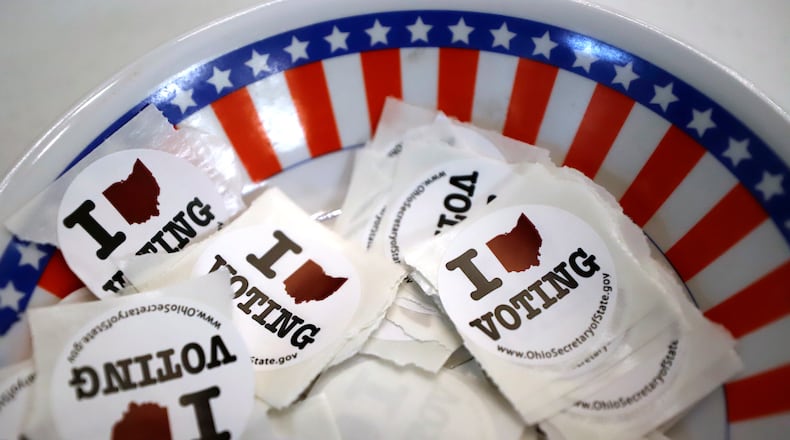But it’s incredibly important that you do.
Even if you’re sick and tired of the partisanship and vitriol or don’t feel like either presidential candidate inspires you to go to the polls this year, there are still a number of races and ballot issues that can have a very real effect on your life and the lives of those in your community.
There are several state races that could dramatically change the course of Ohio’s future.
Three key state races
Issue 1 is a citizen-initiated constitutional amendment that would change how state and federal legislative district maps are drawn. The results of its passage could alter the political landscape of our state for years. However, as we wrote in a previous editorial, the official language that will appear on your ballot is deceptive and might confuse voters. For example, you’ve probably seen yard signs for both “Vote Yes” and “Vote No” on Issue 1 that claim to end gerrymandering. Make sure you’ve read our explainer on Issue 1 and be sure to read both the text that the Issue 1 campaign initially proposed as well as the official ballot language before heading to the polls.
Credit: AP
Credit: AP
The U.S. Senate race between incumbent Sherrod Brown and Bernie Moreno is also closely watched and could change the balance of power in Congress. Choosing who represents Ohio in the U.S. Senate can have a significant impact on how federal priorities and funds are directed to our state. Ohio’s U.S. Senate race is the most expensive congressional race on record, with spending and future ad reservations from the campaigns and their allies totaling $416.4 million, according to AdImpact, an advertising tracking firm that tallied spending earlier this month.
And while they haven’t received nearly as much attention as the Issue 1 or Senate campaigns, the Ohio Supreme Court races could prove pivotal. Three Ohio Supreme Court seats will be decided this year. It’s also a noteworthy year for the Supreme Court race because this is the first presidential election where Ohio voters will see party labels next to candidates for state Supreme Court on their ballots.
Beyond state races, your vote could also determine the outcome for local levies that would have lasting, visible effects on how your community funds its schools, parks, libraries, public safety or mental health services.
Simply put, there’s too much at stake to sit this election out.
We encourage you to read our 2024 November Voter Guide to hear directly from the candidates who will be on the ballot. You can find the Voter Guide on daytondailynews.com/voter-guide.
New election rules
If you haven’t already, make a plan to vote and be sure to educate yourself on new rules and regulations that might apply this year.
Voters wanting to cast a ballot in-person should make sure they bring a valid photo ID to the polls to comply with voter ID laws that went into effect last year. Valid forms of identification include an Ohio driver’s license, a U.S. passport or passport card, a State of Ohio ID card, an interim ID form issued by the Ohio Bureau of Motor Vehicles, a U.S. military ID card, an Ohio National Guard ID card, or a U.S. Department of Veterans Affairs ID card.
Ohioans can still cast a ballot without a photo ID — they just have to vote absentee.
County election boards are open to voters through the Sunday before Election Day:
Oct. 27: 1-5 p.m.
Oct. 28: 7:30 a.m. to 7:30 p.m.
Oct. 29: 7:30 a.m. to 8:30 p.m.
Oct. 30 to Nov. 1: 7:30 a.m. to 7:30 p.m.
Nov. 2: 8 a.m. to 4 p.m.
Nov. 3: 1-5 p.m.
People can vote by mail using only the last four digits of their Social Security number. Those wanting to vote by mail should fill out an absentee ballot application. That application can be dropped off at or mailed to a local county board of elections office. This form must be received by the seventh day before Election Day; during this election, that would be Oct. 29.
Counties also have election drop-off boxes for ballots, but during this election season, voters can only drop off their personal ballots at the box. Ohio Secretary of State Frank LaRose in August ordered that drop boxes only be used for a person delivering his or her own ballot. The state election office requires that people dropping off absentee ballots for others go into the board of elections office to hand in the ballots and sign a form attesting they are following the law.
You make democracy possible
Whether it’s from volunteering for a campaign you care about, helping others get to the polls, registering as a poll worker, or simply showing up to cast your vote, the hard work of democracy is not possible without your participation.
We want to thank our local Boards of Election and our poll workers for ensuring a safe, reliable and secure election and to all of our readers who take seriously the responsibility of actively engaging with our country’s democratic process.
IMPORTANT DATES
Oct. 29: Absentee ballot applications must be received by the election board
Nov. 3: Last day of early, in-person voting
Nov. 4: Absentee ballot postmark deadline
Nov. 5: Election Day, absentee ballots must be returned by mail or hand-delivered to the election board
Nov. 9: Last day for boards of elections to receive non-UOCAVA absentee ballots


